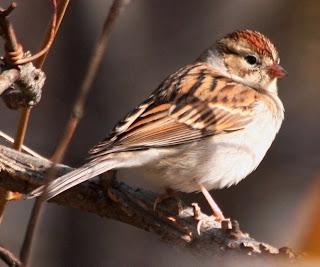Usually conspicuous, they may form sizable flocks during the nonbreeding seasons, often mixing with juncos, lark or clay-colored sparrows, pine or palm warblers, or bluebirds. They frequently give their distinctive flight note upon flushing, usually flying up to a tree or other elevated perch to survey the intrusion. Polytypic. Length 5.5" (14 cm).
Identification All feature dark lores, gray nape and cheek, gray unstreaked rump, 2 white wing bars, and lack of a prominent malar stripe. Breeding adult: bright chestnut crown, distinct white eyebrow, black line from bill through eye to ear. Winter adult: browner cheek, dark lores, streaked crown with some rufous color. First-winter: similar to winter adult, but brownish crown; buff-tinged breast and sides. Juvenile: underparts prominently streaked; crown usually lacks rufous; may show slightly streaked rump. Plumage often held into October, especially in western subspecies.
Geographic Variation Seven subspecies (3 in North America) show moderate variation in color and measurements. Nominate eastern subspecies is small and fairly dark, with rich rufous upperparts. Western subspecies include the large, pale arizonae (breeds from Great Plains west) and the fairly small stridula (coastal British Columbia to southern California), which is intermediate in color.
Similar Species Clay-colored and Brewer’s sparrows differ from winter and immature chippings by their pale lores, prominent malar and submoustachial stripes (particularly clay-colored), and brownish rumps; lack chestnut on the cap. The Brewer’s has a streaked nape and rump, and a duller face pattern with a more distinct eye ring; the clay-colored is typically warmer buff-brown on the breast, especially in fall, and has a broader, pale supercilium and a more strongly contrasting gray nape.
Voice Call: high tsip; sometimes a rapid twitter when excited. Flight note: high, sharp tseet; sharper at beginning of note than Brewer’s or clay-colored’s. Song: rapid trill of dry chip notes, all 1 pitch; speed can vary considerably.
Status and Distribution Common. Occurs south to Nicaragua. Breeding: lawns, parks, gardens, woodland edges, pine-oak forests. Migration: spring mid-March–mid-May; fall late July–early November, peaking September–late October. Rare in winter north of mapped range. Vagrant: casual to western Alaska.
Population Stable. Has largely benefited from human activities, including the clearing of forests and creation of open, grassy parks.
—From the National Geographic book Complete Birds of North America, 2006
Identification All feature dark lores, gray nape and cheek, gray unstreaked rump, 2 white wing bars, and lack of a prominent malar stripe. Breeding adult: bright chestnut crown, distinct white eyebrow, black line from bill through eye to ear. Winter adult: browner cheek, dark lores, streaked crown with some rufous color. First-winter: similar to winter adult, but brownish crown; buff-tinged breast and sides. Juvenile: underparts prominently streaked; crown usually lacks rufous; may show slightly streaked rump. Plumage often held into October, especially in western subspecies.
Geographic Variation Seven subspecies (3 in North America) show moderate variation in color and measurements. Nominate eastern subspecies is small and fairly dark, with rich rufous upperparts. Western subspecies include the large, pale arizonae (breeds from Great Plains west) and the fairly small stridula (coastal British Columbia to southern California), which is intermediate in color.
Similar Species Clay-colored and Brewer’s sparrows differ from winter and immature chippings by their pale lores, prominent malar and submoustachial stripes (particularly clay-colored), and brownish rumps; lack chestnut on the cap. The Brewer’s has a streaked nape and rump, and a duller face pattern with a more distinct eye ring; the clay-colored is typically warmer buff-brown on the breast, especially in fall, and has a broader, pale supercilium and a more strongly contrasting gray nape.
Voice Call: high tsip; sometimes a rapid twitter when excited. Flight note: high, sharp tseet; sharper at beginning of note than Brewer’s or clay-colored’s. Song: rapid trill of dry chip notes, all 1 pitch; speed can vary considerably.
Status and Distribution Common. Occurs south to Nicaragua. Breeding: lawns, parks, gardens, woodland edges, pine-oak forests. Migration: spring mid-March–mid-May; fall late July–early November, peaking September–late October. Rare in winter north of mapped range. Vagrant: casual to western Alaska.
Population Stable. Has largely benefited from human activities, including the clearing of forests and creation of open, grassy parks.
—From the National Geographic book Complete Birds of North America, 2006




